I saw Alex at the base of the stairs as I was coming down to get my breakfast. He just said 'we are going to release it in ten minutes' full of excitement and walking in a hurry. The seas had calmed down over night and we were at the position of the first mooring!
I eat as fast as I could. I normally would have skipped breakfast so I would not miss any of the action, but empty stomach for a bad sailor is a recipe for disaster. I donned my float jacket, baklava and all that, as I knew I would be out in the cold for a while.
My job on the whole deal was to produce a video of the recovery. I am pretty happy with the results, and now I will wait until we get on land to post it. I had a good idea of what the recovery was going to be like since Jim Ryder (there are two Jim in our group) gave a briefing about the whole process. I am amazed how things were just like Jim explained. I even used the audio of the briefing in the video to explain what is happening.
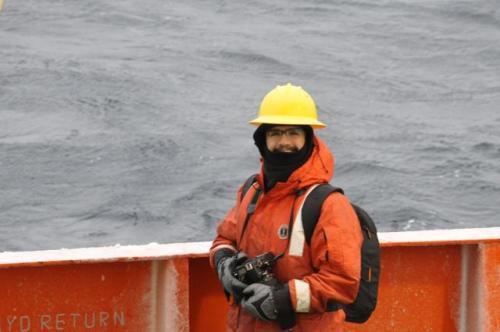
I headed for the bridge, were we can have a full 360 degrees view of the ocean. We needed to find the two large orange buoys or the smaller yellow plastic casing of the glass buoys (a description of the moorings on the March 18 journal entry). Alex said it takes 2 to 3 minutes between the release and the appearance of the first buoy. This is a stress full moment, as we search for the floats. The release mechanisms might fail (that is why we put two and not only one), or the mooring might have detached anytime since it was placed last year. We will not get a single datum if we do not recover the equipment. It is all or nothing!
At bout five minutes after the release Buzz spotted the orange buoy ahead of us next to a small ice patch. A couple of minutes later the other buoys popped up.
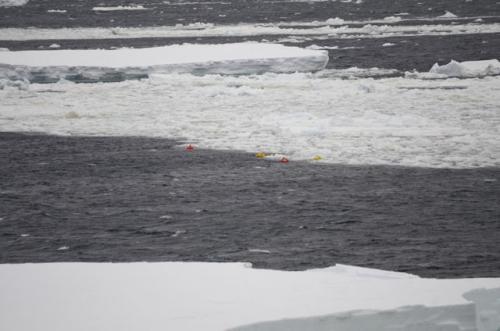
I rushed down in time to capture the ship's approach to the mooring. Jim used a 12 feet pickup pennant to hook the buoy and took the rope to the A-frame.
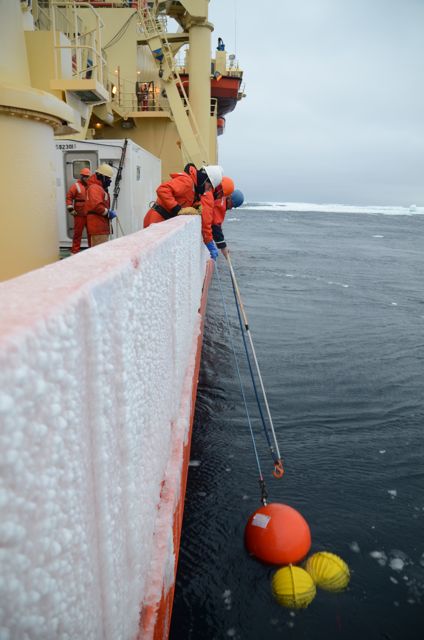
The first buoy was lifted with the A-frame
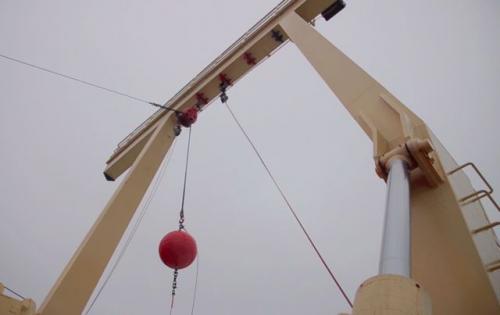
Jim and Barry removed it from the cable in a very elaborate dance. They first had to attach the mooring line to another winch before removing the buoy. Then they reattached the mooring line to the A-frame to keep pulling the instruments. They removed the line to the smaller winch and pull the next item on the line. They removed the oceanographic instruments as they arrived on deck and sent them inside. The buoys were placed on rubber tires. The hoisting continued. A very well orchestrated choreography that brought invaluable data onboard.
You can see in the next picture that the current meter is part of the line of the mooring. Jim, on the left, added a green rope and attached it to the small winch. They needed to remove the current meter and the yellow glass buoys without letting go of the mooring line, since there were other instruments attached to it. Perhaps the most amazing thing was to see Jim perform all this work with bare hands in the cold air and frigid water.
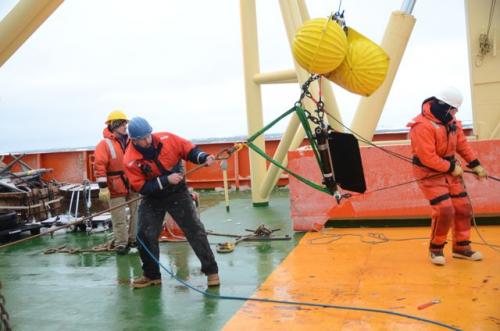
There was a small accident that could have been very bad. At one point the ship moved faster than one of the cables allowed and it snapped. It was so fast that Barry, who was closest to the line, had not time to react. Luckily it did not harm him.
We sailed a few hours to the second mooring. Jim, Alex and Buzz spent some time listening to the release and triangulating until they found it. We were loosing daylight thanks to a heavily overcast sky. We were having trouble finding the buoys form the bridge under those conditions. It was very tense up there in the bridge. Nancy, aided by binoculars, spotted the buoys quite far from the ship. A big sigh of relief was heard.
The second recovery went smoother, even when there was less light and some snow. Alex is extremely happy to have recovered both moorings. The instruments are expensive, but it is the data inside them that make them so much more valuable. The plan is to open them on Tuesday, once the mooring team has had tome to rest after three long and stressful days for them.
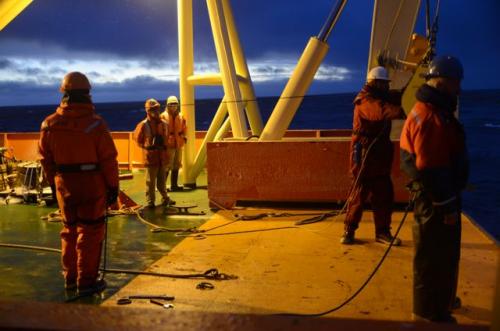
IFondeos recuperados
Ví a Alex en el rellano de las escaleras cuando bajaba desayunar. Lleno de emoción y moviéndose muy aprisa apenas alcanzó a decirme 'los liberaremos en diez minutos'. El viento y la marejada se habían tranquilizado durante la noche y estábamos en le sitio del primer fondeo.
Comí lo más rápido que pude. En otras circunstancias me habría saltado el desayuno por no perderme nada de la acción, pero panza vacía para un mal marinero es una buena receta para el desastre. Me puse mi chamarra de flotación, mi pasamontañas y todo el resto del equipo pues sabía que estaría en el frío por un buen rato.
Mi trabajo en toda la operación era realizar un video sobre el proceso. Ya lo acabé y estoy muy satisfecho con lo que logramos. Ahora tendré que esperar a llegar a tierra firme para colgarlo en la página. Tenía una buena idea de lo que iba a pasar porque Jim Ryder (hay dos Jim en nuestro grupo) no había dado una plática sobre el proceso. Me sorprendió ver lo bien que se apegó su explicación a lo que realmente sucedió. Incluso usé el audio de su charla en el video.

Me dirigí hacia el puente, desde donde tenemos una vista de 360 grados. Necesitábamos encontrar las dos boyas naranjas o las las de plástico amarillo con los flotadores de vidrio dentro (la descripción de los fondeos en el 18 de marzo). Alex dijo que los flotadores tardan entre 2 y 3 minutos para salir tras ser liberadas. Son momentos de gran estrés. El mecanismo de liberación puede fallar (por eso se pusieron dos), o el fondeo se pudo haber liberado sólo hace tiempo. No obtendremos un sólo dato si no recuperamos los instrumentos.
Buzz divisó la primer boya como a los cinco minutos de haberse liberado. Estaba frente al buque cercad e un parche de hielo. Las demás boyas salieron tras unos minutos más.

Baje a cubierta para capturar el acercamiento a las boyas. Jim usó una pértiga de 4 m de largo para enganchar la boya. De ahí al 'A=frame' del barco.

La primer boya al ser izada desde el A-frame

Jim y Barry removieron la boya del cable en una danza elaborada. Tuvieron que amarrar el cable del fondeo a otro winche antes de remover la boya. Después conectar el cable del fondeo al A-fram de nuevo para poder segui jalando el resto de los instrumentos. Quitaron la linea al pequeño winche y siguieron jalando el cable. Quitaron los instrumentos oceanográficos conforme llegaron a cubierta, y se los llevaron al interior del barco. Las boyas fueron colocadas en llantas de auto para que no rodaran y continuó el proceso. Una coreografía muy bien orquestada que arrojó trajo datos importantes al barco.
Puedes ver en la siguiente foto que el correntímetro forma parte de la línea del fondeo. Jim, a la izquierda, agregó una cuerda verde para poder jalar hacia adentro el correntímetro y las dos boyas de vidrio con el winche pequeño. Necesitaron quitar el correntímetro y los flotadores sin dejar ir la línea del fondeo, ya que quedaban varios instrumentos colgados. Quizá la parte más impresionante fue ver a Jim trabajar en el viento frío y las aguas gélidas sin guantes.

Hubo un pequeño accidente que pudo haber sido fatal. El barco comenzó a moverse a una velocidad muy rápida para el cable del fondeo por lo que se reventó. Todo ocurrió tan aprisa que cuando Barry, quien estaba más cerca, reaccionó, el pedazo de cable ya se le había enroscado. Afortunadamente no le hizo daño.
Navegamos unas cuantas horas hacia el segundo fondeo. Jim, Alex y Buzz estuvieron escuchando al liberador y haciendo la triangulación para ubicarlo inequívocamente. Perdíamos la luz del día gracias a un cielo muy nublado. Se nos dificultó más el encontrar las boyas desde el puente de mando. Fueron momentos muy tensos, hasta que Nancy, con ayuda de unos binoculares, ubicó las boyas.
La recuperación del segundo fondeo se realizó sin contratiempos, aún cuando había menos luz y algo de nieve. Alex está sumamente contento de haber recuperado ambos fondeos. Los instrumentos son caros, pero los datos que llevan adentro los hacen todavía más valiosos. Se planea sacarles los datos el martes, una vez que el equipo de los fondeos haya descansado tras estos tres días de mucho estrés.



Comments